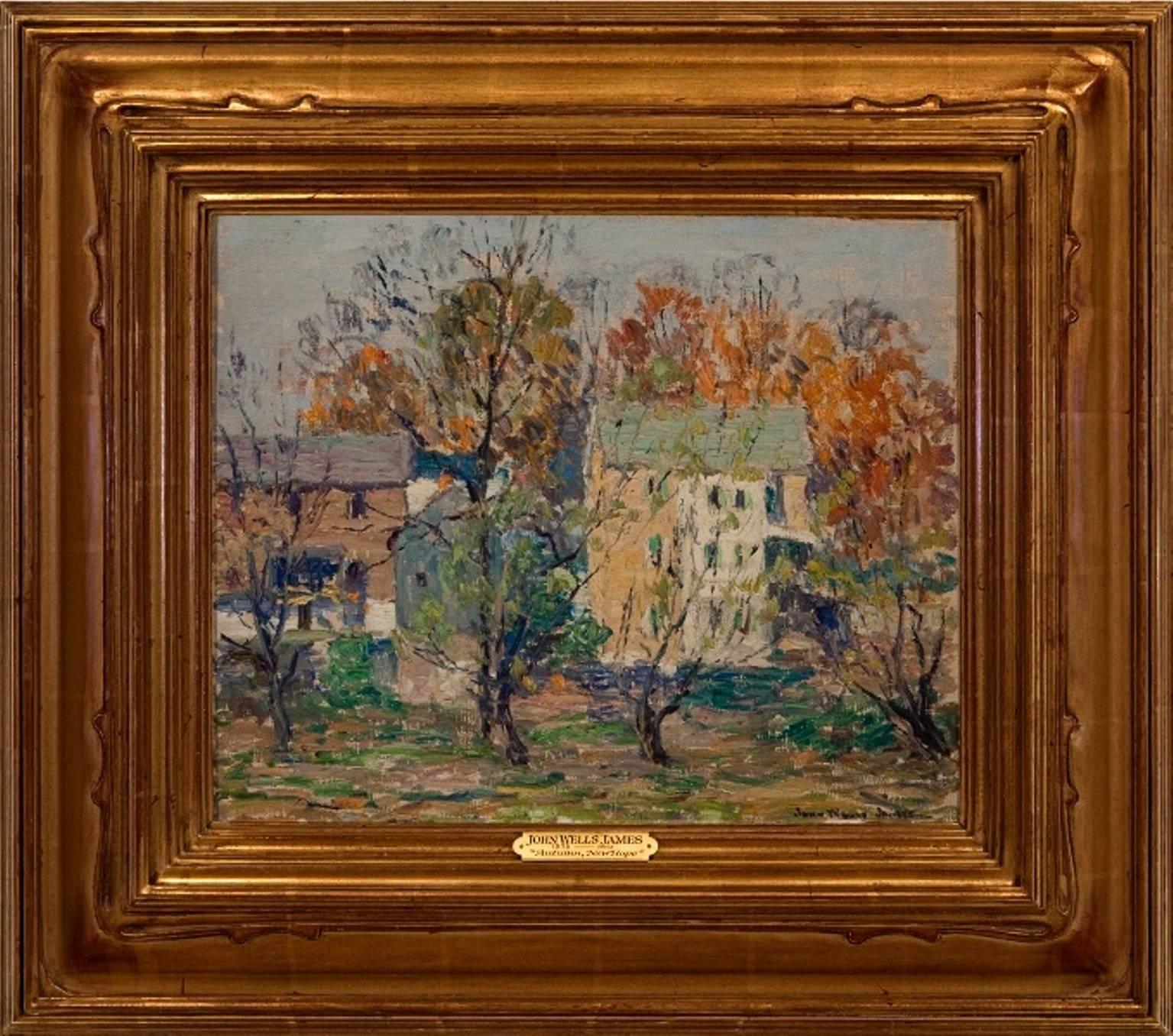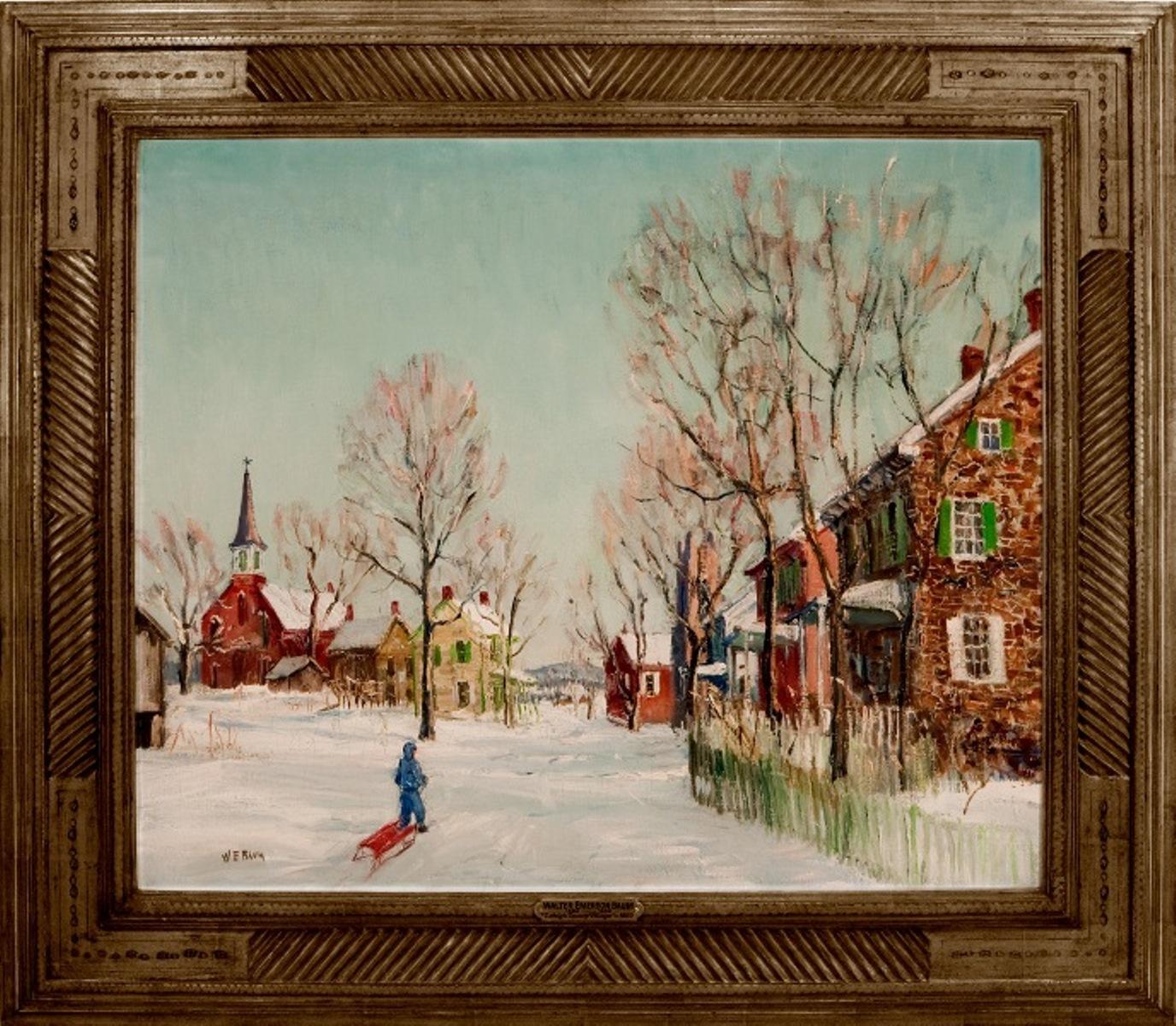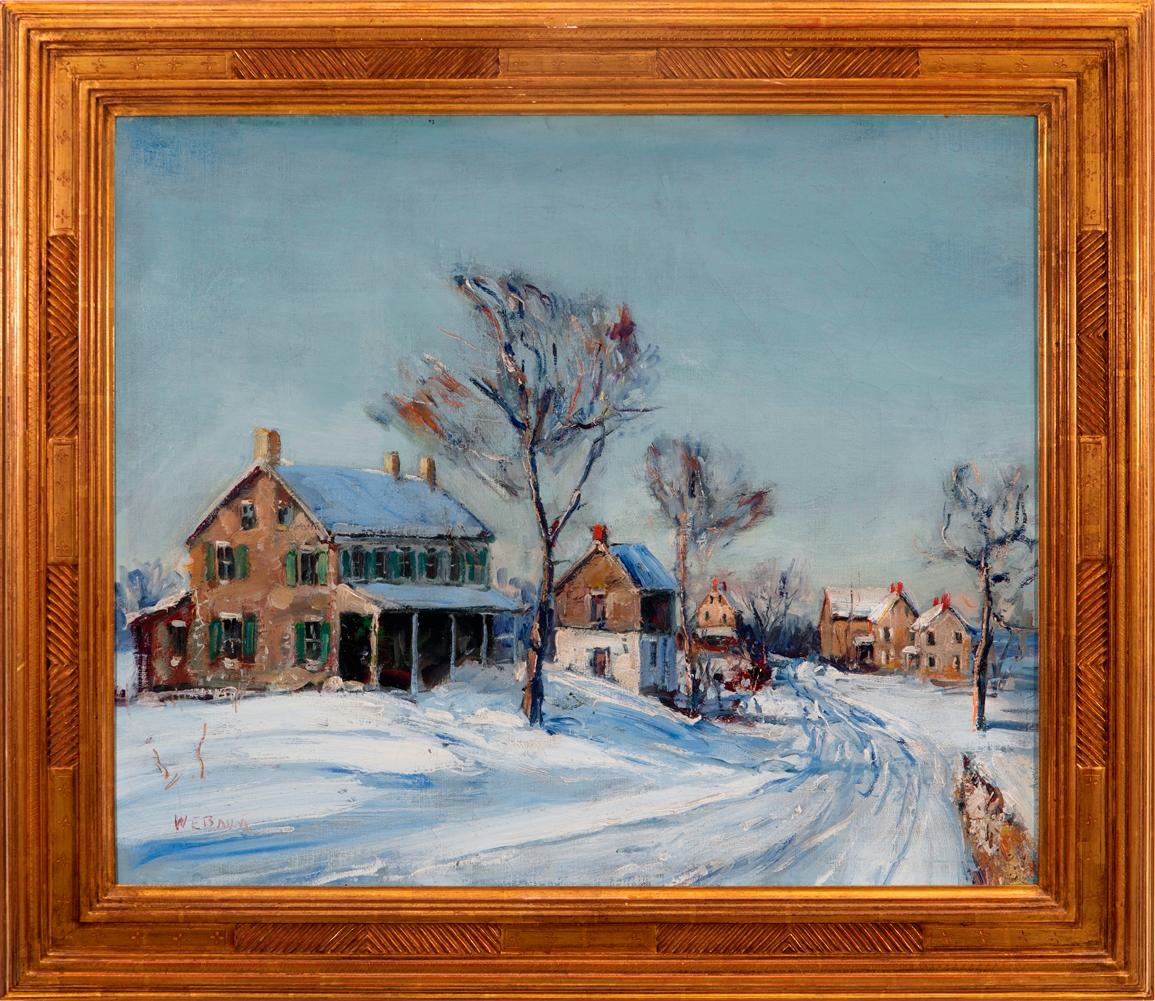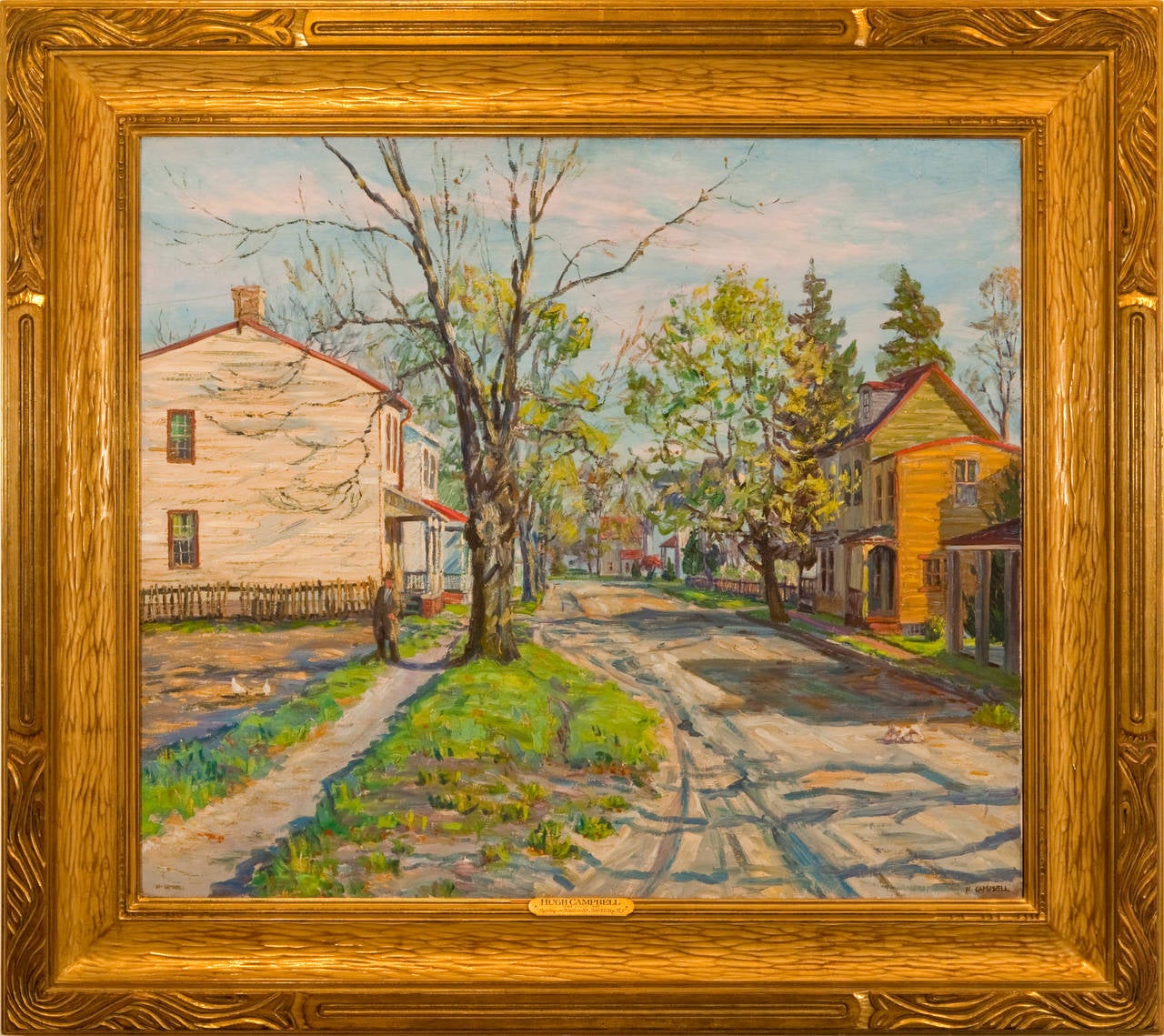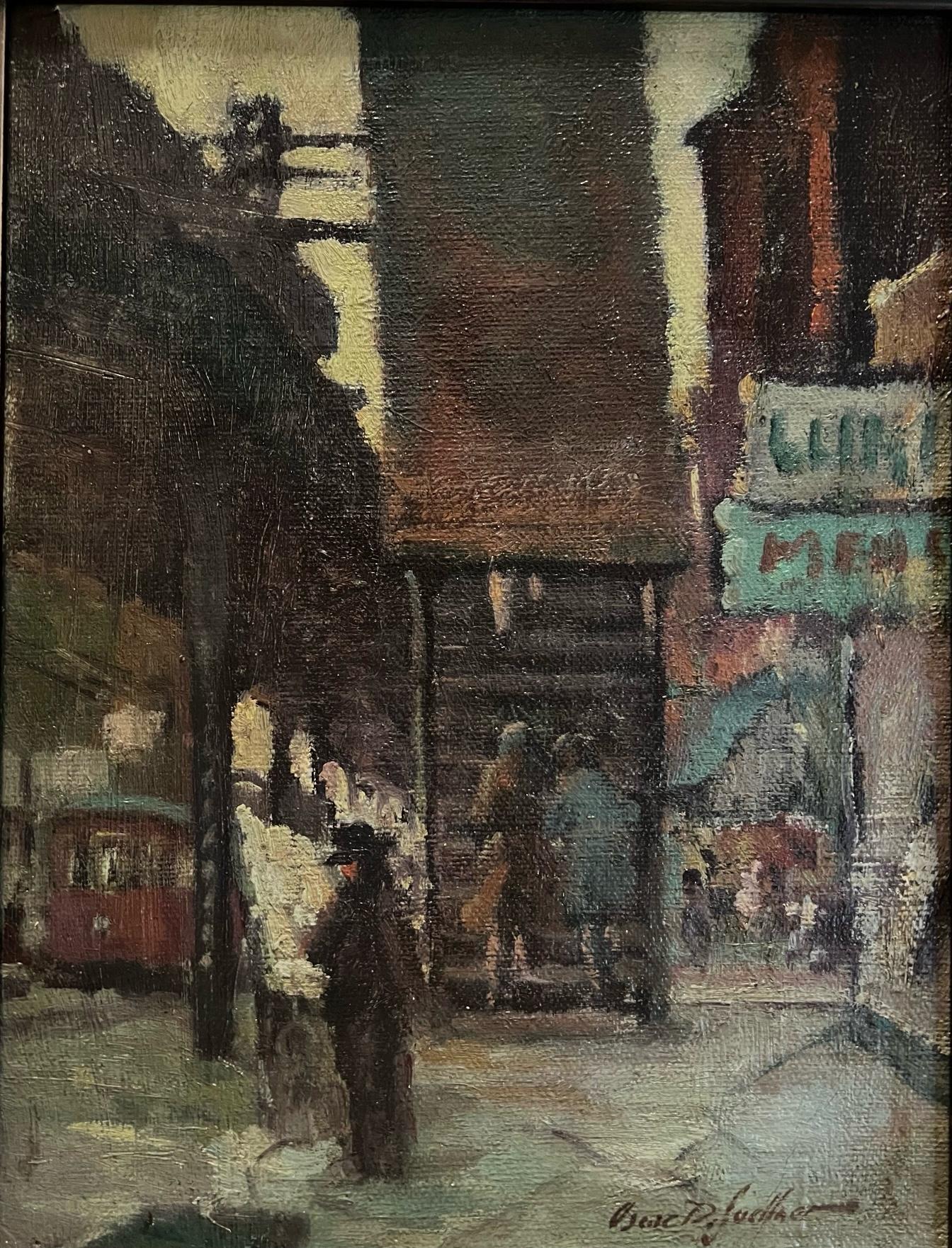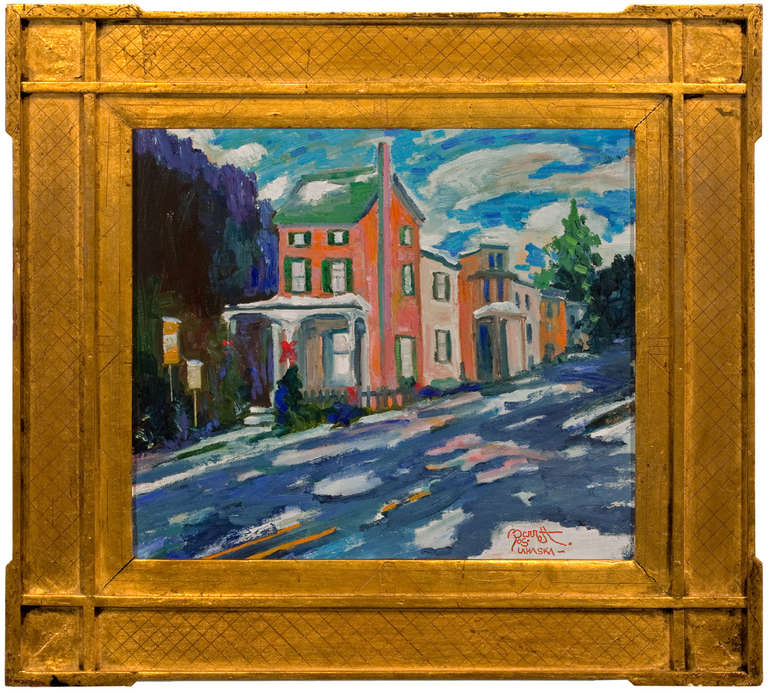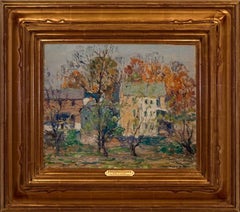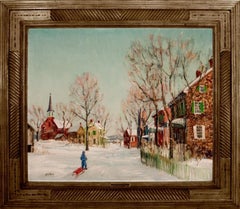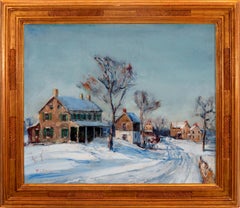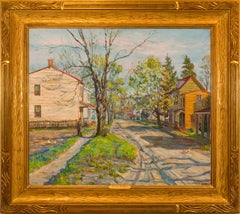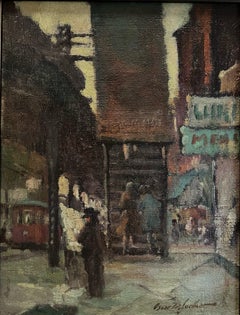Want more images or videos?
Request additional images or videos from the seller
1 of 5
John Wells James"A New Hope Street"c. 1928
c. 1928
$35,625
£27,014.39
€31,256.90
CA$50,357.23
A$56,138.64
CHF 29,278.61
MX$678,846.27
NOK 368,046.48
SEK 348,245.52
DKK 233,300.85
About the Item
Jim’s of Lambertville is proud to offer this artwork.
Signed lower left.
Complemented by a hand carved and gilt frame.
Illustrated in "New Hope for American Art"
John Wells James (1873 - 1951)
A master of both landscape and still life painting, Brooklyn-born John Wells James was a significant member of the New Hope Art Colony. He was the president of a successful wholesale drug company in Brooklyn, New York, of which he owned in partnership with his three brothers. Although James had spent time studying with several fellow artists such as Max Kuehne and James Knox, he was proclaimed to be largely a self-taught artist.
James purchased a summer home in Solebury, near New Hope in the 1920s. Dividing his time between New Hope and Brooklyn, James maintained studios in both locations. He is remembered most for his tightly constructed impressionist landscapes of the picturesque scenery along the Delaware River. Colorful and fresh, his painterly canvases resonated with collectors within the art community. He exhibited frequently at the Phillips Mill with the New Hope crowd as well as in New York at the Salmagundi Club and the National Academy of Design, also at the Pennsylvania Academy of Fine Arts, the Carnegie Institute and the Corcoran Gallery of Art.
James, passionate about flowers, created a fairly substantial body of still life paintings. These delicate compositions were carefully created as the artist studied his subject in the same way a portrait painter would study his sitter. His goal was to capture the individuality and expression of each flower which had been gathered from the garden of James’ Solebury home.
A great inspiration to James was artist Ernest Lawson, who was said to be his favorite painter. James spent time in New England as well as abroad on various painting excursions. He was especially fond of Spain. Also among his talents, was frame-making, an art which he most likely learned from close friend, Max Kuehne. John Wells James died in 1951 while traveling in France.
Sources:
-New Hope for American Art by James M. Alterman
-American Artist, June 1945
-Bianco Gallery Archives, 1995
- Creator:John Wells James (1873-1951, American)
- Creation Year:c. 1928
- Dimensions:Height: 22 in (55.88 cm)Width: 24 in (60.96 cm)Depth: 2 in (5.08 cm)
- More Editions & Sizes:Frame Size 21" x 24" x 2"Price: $35,625
- Medium:
- Movement & Style:
- Period:
- Condition:
- Gallery Location:Lambertville, NJ
- Reference Number:Seller: LAM00971stDibs: LU374571682
About the Seller
5.0
Vetted Professional Seller
Every seller passes strict standards for authenticity and reliability
Established in 1997
1stDibs seller since 2014
38 sales on 1stDibs
Typical response time: 22 hours
- ShippingRetrieving quote...Shipping from: Lambertville, NJ
- Return Policy
Authenticity Guarantee
In the unlikely event there’s an issue with an item’s authenticity, contact us within 1 year for a full refund. DetailsMoney-Back Guarantee
If your item is not as described, is damaged in transit, or does not arrive, contact us within 7 days for a full refund. Details24-Hour Cancellation
You have a 24-hour grace period in which to reconsider your purchase, with no questions asked.Vetted Professional Sellers
Our world-class sellers must adhere to strict standards for service and quality, maintaining the integrity of our listings.Price-Match Guarantee
If you find that a seller listed the same item for a lower price elsewhere, we’ll match it.Trusted Global Delivery
Our best-in-class carrier network provides specialized shipping options worldwide, including custom delivery.More From This Seller
View All"Autumn, New Hope"
By John Wells James
Located in Lambertville, NJ
Jim’s of Lambertville is proud to offer this artwork.
Signed lower right.
Complemented by a hand carved and gilt frame.
John Wells James (1873 - 1951)
A master of both landscape and still life painting, Brooklyn-born John Wells James was a significant member of the New Hope...
Category
20th Century American Impressionist Landscape Paintings
Materials
Oil, Board
"Lehigh County Village"
By Walter Emerson Baum
Located in Lambertville, NJ
Jim’s of Lambertville is proud to offer this artwork by:
Walter Emerson Baum (1884 - 1956)
Born in Sellersville, Pennsylvania, Walter Baum was one of the only members of the New Ho...
Category
1930s American Impressionist Landscape Paintings
Materials
Canvas, Oil
"Road to Argus"
By Walter Emerson Baum
Located in Lambertville, NJ
Jim’s of Lambertville Fine Art Gallery is proud to offer this piece by Walter Emerson Baum (1884 - 1956).
Born in Sellersville, Pennsylvania, Walter Baum was one of the only members...
Category
1930s American Impressionist Landscape Paintings
Materials
Canvas, Oil
"Spring on Risdon Street, Mt. Holly, NJ"
By Hugh Campbell
Located in Lambertville, NJ
Jim’s of Lambertville is proud to offer this artwork.
Signed lower right.
Complemented by a hand carved and gilt frame.
Hugh Campbell (1905-1997)
Born December 4, 1905 in Atch...
Category
20th Century American Impressionist Landscape Paintings
Materials
Canvas, Oil
"Little House, Lambertville, NJ"
By Joseph Barrett
Located in Lambertville, NJ
Jim’s of Lambertville is proud to offer this artwork.
Signed lower right
Joseph Barrett (b. 1936)
Joseph Barrett was born in Midland, North Carolina, in 1936 and studied at the M...
Category
20th Century American Impressionist Landscape Paintings
Materials
Oil, Canvas
"Summer Shadows"
By Joseph Barrett
Located in Lambertville, NJ
Illustrated in "Joseph Barrett, The Prime Years 1970s - 1990s", pg. 8 #008
Jim’s of Lambertville is proud to offer this artwork by:
Joseph Barrett (1936 – )
Joseph Barrett was born in Midland, North Carolina, in 1936 and studied at the Massachusetts College of Art in Boston and at the Tyler School of Art in Philadelphia. Barrett, now of Lahaska, Pennsylvania, has been painting his entire adult life. His favorite subjects include the landscape surrounding New Hope and many local landmarks often encompassing figures into his compositions. Barrett utilizes a heavy impasto and his palette bears similarities to that of Fern Coppedge and George Sotter. Barrett’s paintings are always found in unique and somewhat charming handmade frames designed by the artist and finished in metal leaf.
A living contemporary of the no longer living “New Hope School” impressionist painters, Joseph Barrett resides outside of New Hope above his old-fashioned antique shop and studio. Entering Barrett’s shop is like taking a step back in time. Inside this cluttered and dusty haven of treasures from the past, is a studio spanning only four by eight feet. This little studio, containing cans of old brushes and hundreds of used paint tubes...
Category
Late 20th Century American Impressionist Landscape Paintings
Materials
Canvas, Oil
You May Also Like
Lake Street
Located in Los Angeles, CA
Lake Street, c. 1920 -30s, oil on board, 12 x 9 inches, signed lower right and verso, titled verso
About the Painting
At the center of Oscar Daniel Soellner’s Lake Street, we see the stairway leading to an elevated railway station on what is now Chicago’s Green Line route. When its first section opened in 1893 as the second permanent elevated rapid transit line in Chicago, this route was known as the Lake Street Elevated Railroad. Chicago’s “L,” like the New York subway and rapid transit system, played an instrumental role in the development of the urban economy and the overall look and feel of the city. The formal aspects of urban railroads and the role they played in efficiently moving large number of everyday citizens across America’s growing metropolises were catnip for many American Scene painters during the first half of the 20th Century. Here, Soellner uses the techniques of the impressionists and the palette of the Ash Can School, to convincingly depict a classic Chicago scene...
Category
1920s American Impressionist Landscape Paintings
Materials
Oil
Hallman's, American Impressionist Landscape with Figures and Farmhouse
By Albert Van Nesse Greene
Located in Doylestown, PA
"Hallman's" is a landscape with figures and farmhouse, by American Impressionist painter Albert Van Nesse Greene. The painting is a 13.5" x 19....
Category
Mid-20th Century American Impressionist Landscape Paintings
Materials
Pastel, Archival Paper
"Village Green" Mary Bradish Titcomb, Bright American Impressionist Landscape
Located in New York, NY
Mary Bradish Titcomb
Village Green
Signed lower left
Oil on canvas
24 x 20 inches
A native of Windham, New Hampshire, upon graduation from high school, Titcomb studied at the Massachusetts Normal Art School, before accepting a position as a drawing teacher in the public schools of Brockton, Massachusetts, where she remained for fourteen years before resigning, in 1889, to study painting at the School of the Museum of Fine Arts, Boston. Her instructors there included Edmund Charles Tarbell, Philip Leslie Hale, and Frank Weston Benson. In the 1890s she went to Paris to study with Jules Joseph Lefebvre and to travel. She then returned to Boston, taking studio space at the Harcourt Studios, where all three of her teachers kept space. In 1895 she became a member of the Copley Society and began exhibiting locally; from 1904 to 1927 she showed work in 29 exhibits at the Pennsylvania Academy of the Fine Arts. She began signing her name as "M. Bradish Titcomb" in 1905 to avoid prejudice against her gender. The same year saw her making a sketching trip to the artists' colony at Old Lyme, Connecticut, a center for the American Impressionists; this trip seems to have cemented her interest in the style.
In 1915, Titcomb's Portrait of Geraldine J. – the mother of actress Jane Russell – was shown at the Corcoran Gallery of Art and purchased by President Woodrow Wilson; another portrait, of Frank P. Sibley, was reproduced in the Boston Globe. During this period her work was shown in a traveling exhibition with that of Cecilia Beaux, Lydia Field Emmet, Jean MacLane...
Category
1910s American Impressionist Figurative Paintings
Materials
Canvas, Oil
Side Street, Princetown, New York
By Alexander Redein
Located in San Francisco, CA
This artwork titled "Side Street, Princetown, New York" c 1960, is an oil painting on panel by noted American artist Alexander Redein, 1912-1990. It is signed at the lower right corn...
Category
Mid-20th Century American Impressionist Figurative Paintings
Materials
Oil
"Brooklyn, New York" Frederick James Boston, Impressionist Brooklyn Landscape
By Frederick James Boston
Located in New York, NY
Frederick James Boston
Brooklyn, New York
Inscribed verso
Oil on board
7 1/2 x 9 1/2 inches
Though understudied today, Frederick James Boston was a well-known and respected teacher...
Category
Late 19th Century American Impressionist Figurative Paintings
Materials
Board, Oil
Impressionist Painter Rockport Art Association Antonio Cirino Street Scene
By Antonio Cirino
Located in Rockport, MA
Painting size without frame: 8"x10"
Painting size with frame: 15"x16"
This expressive oil painting by Antonio Cirino (1889–1983) captures the quiet energy of a street scene under an overcast sky. The softened light gives the composition a moody atmosphere, while Cirino’s confident brushwork and rich texture animate the buildings and figures with life and movement.
A key figure in the Rockport Art Association and the Cape Ann art...
Category
20th Century American Impressionist Landscape Paintings
Materials
Oil
More Ways To Browse
Antique Street Signs
Antique French Street Signs
Antique Drugs Sign
Alfred Harris Painting
Ann Patrick
Arthur Weeks
Big Bend Painting
Bluebonnet Oil Paintings
Clair De Lune
Henri Martin Impressionist
K Mills
Mikal Jon
Norwegian Tapestry
Oil Painting Old Fisherman
Robert Edward Morrison
Royal Gallery Crystal
Stanley Weiss
Starbucks Art
